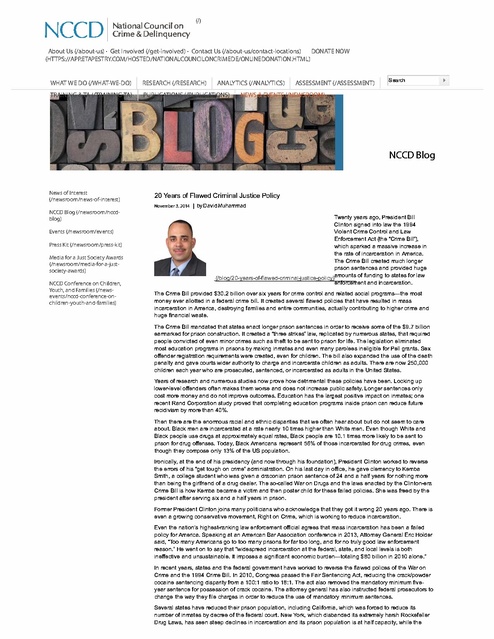20 Years of Flawed Criminal Justice Policy, NCCD - Muhammad, 2014
Download original document:

Document text

Document text
This text is machine-read, and may contain errors. Check the original document to verify accuracy.
NCCD I Na.tionalCo';lncilon Crime & Delinquency (/) About Us (/about-us)· Get Involved (/get-involved)· Contact Us (/about-us/contact-locations) DONATE NOW (HITPS://APP.ETAPESTRY.COM/HOSTED/NATIONALCOUNCILONCRIMEDE/ONLINEDONATION.HTML) WHAT WE DO (/WHAT-WE-DO) RESEARCH (/RESEARCH) A NALYTICS (/ANALYTICS) ASSESSMENT (/ASSESSMENT) I search NCCD Blog News of Interest (/newsroom/news-of-interest) NCCD Blog (lnewsroom/nccd blog) Events (/newsroom/events) Press Kit (/newsroom/press-kit) Media for a Just Society Awards (/newsroom/media-for-a-just society-awards) NCCD Conference on Children, Youth, and Families (/news events/nccd-conference-on children-youth-and-families) 20 Years of Flawed Criminal Justice Policy November 3, 2014 I by David Muhammad Twenty years ago, President Bill Clinton signed into law the 1994 Violent Crime Control and Law Enforcement Act (the "Crime Bill"), which sparked a massive increase in the rate of incarceration in America. The Crime Bill created much longer prison sentences and provided huge of funding to states for law llblog/20-years-0f-flawed-<:riminal-justice-oolicy)amounts _ enforcement and incarceration. The Crime Bill provided $30.2 billion over six years for crime control and related social programs-the most money ever allotted in a federal crime bill. It created several flawed policies that have resulted in mass incarceration in America, destroying families and entire communities, actually contributing to higher crime and huge financial waste. The Crime Bill mandated that states enact longer prison sentences in order to receive some of the $9.7 billion earmarked for prison construction. It created a '1hree strikes" law, replicated by numerous states, that required people convicted of even minor crimes such as theft to be sent to prison for life. The legislation eliminated most education programs in prisons by making inmates and even many parolees ineligible for Pell grants. Sex offender registration requirements were created, even for children. The bill also expanded the use of the death penalty and gave courts wider authority to charge and incarcerate children as adults. There are now 250,000 children each year who are prosecuted, sentenced, or incarcerated as adults in the United States. Years of research and numerous studies now prove how detrimental these policies have been. Locking up lower-level offenders often makes them worse and does not increase public safety. Longer sentences only cost more money and do not improve outcomes. Education has the largest positive impact on inmates; one recent Rand Corporation study proved that completing education programs inside prison can reduce future recidivism by more than 40%. Then there are the enormous racial and ethnic disparities that we often hear about but do not seem to care about. Black men are incarcerated at a rate nearty 1O times higher than White men. Even though White and Black people use drugs at approximately equal rates, Black people are 10.1 times more likely to be sent to prison for drug offenses. Today, Black Americans represent 56% of those incarcerated for drug crimes, even though they compose only 13% of the US population. Ironically, at the end of his presidency (and now through his foundation), President Clinton worked to reverse the errors of his "get tough on crime" administration. On his last day in office, he gave clemency to Kemba Smith, a college student who was given a draconian prison sentence of 24 and a half years for nothing more than being the girtfriend of a drug dealer. The so-<:alled War on Drugs and the laws enacted by the Clinton-era Crime Bill is how Kemba became a victim and then poster child for these failed policies. She was freed by the president after serving six and a half years in prison. Former President Clinton joins many politicians who acknowledge that they got it wrong 20 years ago. There is even a growing conservative movement, Right on Crime, which is working to reduce incarceration. Even the nation's highest-ranking law enforcement official agrees that mass incarceration has been a failed policy for America. Speaking at an American Bar Association conference in 2013, Attorney General Eric Holder said, "Too many Americans go to too many prisons for far too long, and for no truly good law enforcement reason." He went on to say that ''widespread incarceration at the federal, state, and local levels is both ineffective and unsustainable. It imposes a significant economic burden-totaling $80 billion in 201O alone." In recent years, states and the federal government have worked to reverse the flawed polices of the War on Crime and the 1994 Crime Bill. In 2010, Congress passed the Fair Sentencing Act, reducing the crack/powder cocaine sentencing disparity from a 100:1 ratio to 18:1. The act also removed the mandatory minimum five year sentence for possession of crack cocaine. The attorney general has also instructed federal prosecutors to change the way they file charges in order to reduce the use of mandatory minimum sentences. Several states have reduced their prison population, including California, which was forced to reduce its number of inmates by decree of the federal court. New York, which disbanded its extremely harsh Rockefeller Drug Laws, has seen steep declines in incarceration and its prison population is at half capacity, while the

